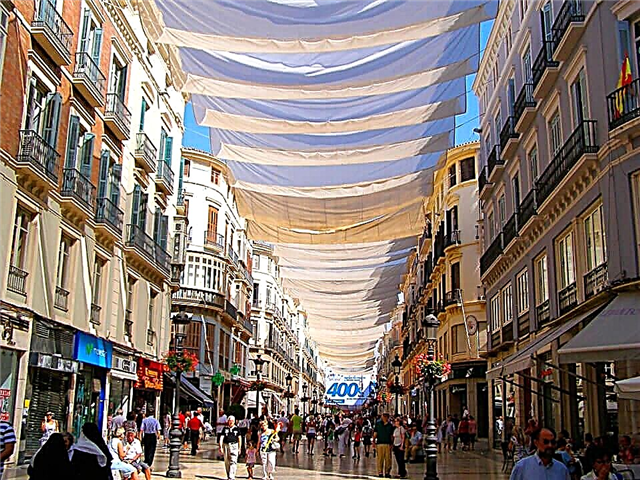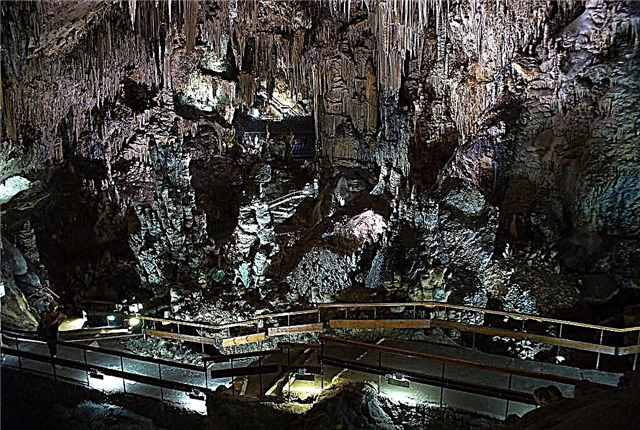The history of the appearance of the Solovetsky Monastery dates back to the 40s of the 15th century, when the Monks Zosima and Herman chose Bolshoi Solovetsky Island in the White Sea as their place of residence.
Short story
According to one of the legends, Zosima had an extraordinary vision, the object of which was a church of indescribable beauty. Surrounded by a heavenly glow, she stood in the east.
Seeing in a vision a sign from above, in 1436 Zosima and his companion built a temple of wood with a refectory and a side-altar - through its construction they honored the Transfiguration of the Lord. After some time, in honor of the Dormition of the Most Holy Theotokos, the monks built a church, and both buildings became the main buildings of the Solovetsky Monastery.

Solovetsky Monastery from a bird's eye view
Jonah, Archbishop of Novgorod, issued the monastery with a document confirming its eternal ownership of the Solovetsky Islands. In the future, such a letter was issued to the monastery and all subsequent Moscow sovereigns. The image of the monastery, standing in the middle of the White Sea, was present on all ancient maps of Muscovy of the 16th century, and its appearance symbolized the unity of statehood and the Orthodox faith in Northern Russia. Historians noted that many significant cities were not on the old maps, and the Solovetsky Monastery, as an outpost of Russia, was always present at them.

View of the Spaso-Preobrazhensky Solovetsky Monastery from the White Sea
Since the second half of the 16th century, construction work with the use of stone has been carried out in the monastery under the leadership of Abbot Philip. From 1552 to 1557 with the participation of the best architects, the monks are working on the construction of the Church of the Dormition of the Mother of God with the Refectory and the Kelare chambers. During the same five years, the monks expanded the monastery pastures, laid roads, and built mills. The lakes, the number of which exceeds 70 names, are connected into a single system thanks to the laying of canals. A farm appears on the island of Muksalma. Finally, the main church of the Solovetsky monastery was laid and erected - the Transfiguration of the Savior, which was consecrated in 1566.

Korozhnaya tower
At the end of the 16th century, the monastery on the Solovetsky Islands receives the status of a fortress - it protects the northwestern borders of the Russian state. In 1578 Ivan the Terrible himself handed over artillery to the monastery-fortress, and 6 years later Tsar Fyodor Ivanovich issued a decree on the construction of stone walls around the monastery site. The work was carried out for 12 years, and as a result, the monastery was surrounded by 11-meter walls of 6-ton smooth boulders. For strength, a lime mortar was laid between them with a gasket in the seams of the brick. The largest boulders are located at the bottom and play the role of a basement. With the gradual decrease in the higher stones, the wall becomes thinner. In the upper part of the walls, looking inside the monastery courtyard, there are covered wooden galleries - from them, the attacking enemy was fired through the loopholes.

Holy gates under the Church of the Annunciation
The artillery was mounted on several tiers of tower floors. There are 8 tower structures in the monastery. Spinning, Watchtower and Uspenskaya are visible from the side of the Bay of Prosperity. Leavened, White, Povarennaya, North and South towers stand in relation to the courtyard from the side of the Holy Lake. All cone-shaped towers end with high tents with watch platforms equipped in them. Similar to the construction of the walls, the towers at the base were laid out of massive boulders, and at the top, under the tents themselves, of bricks. The difference in the thickness of the lower and upper parts of the walls reaches 4.5 m (at the bottom, these values vary within 5 - 6 m, and at the top they are the same and amount to only 1.5 m). Despite this, all the walls and towers were so strong that no enemy force could damage them and penetrate the monastery lands.

Korozhnaya tower with a part of the monastery wall
Real military glory came to the monastery during the Crimean War, when it had to withstand a single, but very powerful bombardment by British 60-gun frigates (the event dates back to 1854). The cannonade lasted for 9 hours, and during this time the warships fired about two thousand bombs and cannonballs from their cannons. But they had to sail away without results, because by their actions they managed to achieve only minor damage to individual buildings.

Cooking tower
Architectural features of the Solovetsky Monastery
The territory of the monastery has a pentagonal shape. All of it is surrounded by massive walls with seven gates. The total length of the walls is 1084 m. Today, in the courtyard of the monastery, there are churches and some buildings, connected by covered passages and surrounded by residential and household premises.

Cathedral of the Transfiguration
In addition to the three-domed Assumption Cathedral and the five-domed Transfiguration Cathedral, there are three churches on the territory of the Solovetsky Monastery: Trinity, Annunciation, Nikolaev. Stone chambers, a bell tower and a water mill stand separately. The external appearance of both cathedrals seems austere, almost serf-like.
Thus, the corner chapels of the Transfiguration Cathedral resemble fortress towers, and the thickness of its walls reaches 5 m. In general, the architectural design of the cathedral is rather complicated. Corner chapters rise above the upper aisles, and those, in turn, are connected by passages and stand on the vaults.

Assumption tower
In 1923, a disaster struck the monastery courtyard - a severe fire led to the fact that some of the bells and spire melted. But restoration work on the bell tower building was not carried out, and a metal star took the place of the fallen cross. In 1985 it was dismantled and transferred for storage to the Solovetsky Museum. In 2003, the reconstruction of the spire of the bell tower took place, and upon its completion a majestic titanium cross appeared in its place.

Gallery
The Aleksandrovskaya and Petrovskaya chapels in front of the monastery courtyard did not lose their original appearance. Their construction in the middle of the 19th century immortalized a visit to the monastery - an ancient fortress by tsars Alexander II and Peter I. There is a sundial at the entrance to the monastery - an uncharacteristic decoration detail for Orthodoxy.

From left to right: Church of St. Nicholas the Wonderworker with a bell tower, Transfiguration Cathedral
The iconostasis of the Transfiguration Cathedral of two dozen boards, lined up in 3 rows, after the "Solovetsky sitting" was taken out by the Old Believers. At the beginning of the 21st century, a citizen of Lithuania announced to the whole world that he had boards from the Preobrazhensky iconostasis, and put them up for sale, setting a price of 1 million 700 thousand euros for all seven boards. At the same time, the icons were on display in Groningen. But after the Ministry of Culture considered the purchase of the iconostasis, it was announced that the state was not interested in such an expensive purchase. This decision was made after the conclusion of the restorers who doubted the authenticity of the iconostasis.

Nikolskaya tower and Nikolskie gates
Worship crosses - monuments of the Solovetsky Monastery
The cross-monument, issued in honor of the Pechersk miracle workers Theodosius and Anthony, can be seen 6 versts from the monastery in the direction of the St. Isaac's skete. Monk Diodorus, a resident of the Holy Ascension Skete, worked on its creation. Earlier in this place there was a chapel in honor of the mentioned miracle workers, and an old carved cross, made in the 17th century, was preserved in it. During the camp, a wooden chapel with a valuable cross was lost.

Inside the Spinning Tower
In total, the servants of the Solovetsky Monastery from the end of the 20th century to the beginning of the 21st century installed up to 20 worship crosses. According to Archimandrite Joseph, the abbot of the monastery, the crosses serve as a kind of monuments, transmitting to generations the former greatness of the ancient monastery, since the places of their installation have traditionally become the lost chapels, temples and memorial places for the life of the monastery.

Inside the Gallery
Solovetsky Monastery as a prison
For 4 centuries, the monastery on the Solovetsky Islands was used as a political and church prison. Chambers resembling a truncated cone were located in the walls and towers of the monastery. The chambers were 3 m long, 2 m wide and high, and at the narrow end they occupied only 1 m. But in some towers the chambers were even closer. So, in the Golovlenkovskaya tower, they were located on the upper floors and occupied 1.4 m in length and 1 m in height and width. The small window in the cells was for serving food, not for lighting. While in custody, the prisoners were not supposed to lie - they were allowed to sleep in a bent state.

View of the Metropolitan Philip Church
In another tower of the Solovetsky Monastery with the name Korozhnia, there were prison cells on each floor. The dark and cramped closets had no doors. In order for the prisoner to be inside, he had to crawl through the small holes provided in the cells as an entrance with difficulty. The number of prison cells in the monastery grew steadily. In 1798, one of the existing buildings was converted into a prison, and in 1842 a three-story building and separate barracks for guards were specially erected to keep the prisoners. In the semi-underground, on the lowest floor of this new prison, there were small closets. They had no shops or windows, and placed especially dangerous criminals in such harsh conditions.
Attraction rating:











